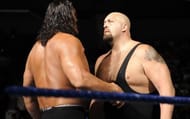As I surfed through my TV channels on a Friday evening after a tiring day at work, I chanced upon ‘World Wrestling Entertainment (WWE) Raw’ on Ten Sports. A sudden flashback of yesteryear flashed through my mind. “Those were the days,” I said to myself loudly, like a 65-year-old pensioner. It had been many years since I had watched ‘professional wrestling’ on TV. “You know I used to watch this regularly then,” I told my wife who responded with a ‘huh-uh’. I don’t blame my wife for her nonchalance towards the WWE because like me she hasn’t grown up watching legalised violence that seemed entertaining.
Vince McMahon didn’t just create the WWE (former WWF) but a cult that will be difficult to rival. The formula that made the WWE a success was simple – a ‘world championship’ for either gender which was sought by all the wrestlers, ‘tag team championship’ for wrestling pairs, then there were secondary titles like ‘Intercontinental Championship’, ‘Money in the Bank’, ‘World Heavyweight Championship’, ‘World Hardcore Championship’, etc. With time the names of the titles changed or some of them were merged with others, however, it’s the wrestlers, controversies and scripted scandals that made the difference.
In the ‘Attitude Era’, The Rock, Stone Cold Steve Austin, The Undertaker, Kane, Ric Flair, Kurt Angle, Triple H, Chris Jericho, Randy Orton, The Big Show and many others who with their traits –be it wrestling, talking, entrance to the ring – made WWE and its viewing absolutely sensational. I mean who wouldn’t like a guy whose entrance music sounds culinary and he justifies that by reducing his opponents to mashed potatoes? Does that ring a bell? “If you smell what The Rock is cooking.” Then there was Stone Cold Steve Austin who was anything but ‘cold’ in his head. He was popularly known as the ‘toughest SOB in the WWE’. You know why? As “that’s the bottom line. Because Stone Cold said so!”
These two gentlemen were very popular and arguably the poster boys of the WWE then but it was The Undertaker who was the X-factor. Clad mostly in a black hat, long overcoat and gloves – ‘the deadman’ was the most feared in the WWE locker room. The dark attire was perhaps a symbol of the dark persona he had. The opponents were scared, shit scared of him. His entrance to the ring sent chills to the spine of the challengers, many of whom lost the battle even before the match begun. An entrance that began with complete darkness in the arena. I as a viewer would often get nightmares of that slow walk of his and the rolling of the eyes in the back of his head. Oh creep. That surely was pant-wetting experience for an opponent. Once in the ring, the scary man would remove his overcoat and his hat. The match would then begin. And the monster did whatever he wanted to.
Barring a few superstars, the scripts would often treat most of the wrestlers good or bad alternately. Triple H was perhaps the most controversial and the perennial villain in the WWE. One would barely see him as a good guy, cheered by the crowd. Why would anyone not boo a man who often used a sledge-hammer from below the ring to thrash his opponents during a match? His pompous, boring rhetoric would annoy people even more and would love seeing his downfall in the ring, no matter who the opponent.
There was also an Indian connection in the WWE. No, it’s not the very popular ‘The Great Khali’ of today but a certain Tiger Ali Singh of yesteryear who didn’t gain widespread fame in the WWE. If anything, his stint ended with an injury and a lawsuit against the company. Nevertheless, his few appearances filled hearts of fools like me with pride before of course The Great Khali came into the picture.
The eccentric superstars were often made to wrestle in eccentric matches, like ‘Tables, ladders and chairs’, ‘No holds barred’, ‘cage match’, ‘casket match’, the inhuman ‘barbed wire match’ and so on. Of all it was The Royal Rumble that was fun to watch. A lead-up to the iconic Wrestle Mania, this event sees a wrestler come to the ring every few minutes and tries to fling the ones inside out. The last man standing will be the challenger to the current champion in the Wrestle Mania. This often sprung surprises with unexpected men standing tall in the ring after the rumble.
WWE was a huge hit off the TV screen too. Merchandise ranging from shirts, DVDs and toys were popular among kids. WWE cards became a fad as kids wrestled each other by stats like wrestlers’ height, weight, rank, etc. In that ever-increasing popularity of the WWE, how would Bollywood not miss an opportunity? Some action movies used professional wrestlers’ lookalike in stunt scenes. It was Khiladiyon ka Khiladi which famously used poor lookalikes of The Undertaker and The Crush in fight scenes with Akshay Kumar. And it was a horrible scene like the movie itself I am sure which reduced the wrestling gods to mere caricature (shame on you Akki baby!).
All these memories somehow define a part of my childhood. Why exactly I liked the WWE is still unclear – perhaps it was an emotional release for a physically weak kid, a strange desire to see role models in those wrestlers or maybe pure thrill. Whatever the case be, it was entertainment. The next time I chance upon ‘WWE Raw’ or ‘SmackDown’ on TV, I will try not to recollect those days. My wife won’t understand what it meant to me. Perhaps no one will.


